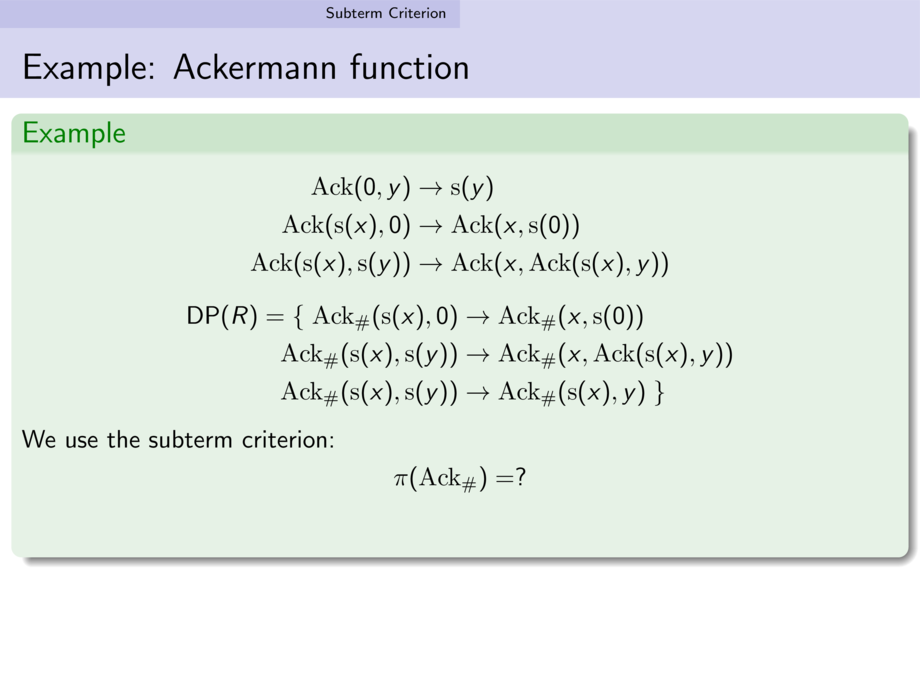



































































































279/365
\begin{frame}[t]
\frametitle{Example: Ackermann function}
\vspace{-1em}
\begin{example}
\vspace{-1em}
\begin{align*}
{\rm Ack}(0,y) &\to {\rm s}(y)\\
{\rm Ack}({\rm s}(x),0) &\to {\rm Ack}(x,{\rm s}(0))\\
{\rm Ack}({\rm s}(x),{\rm s}(y)) &\to {\rm Ack}(x,{\rm Ack}({\rm s}(x),y))
\end{align*}
\vspace{-3.5em}
\pause
\begin{align*}
\DP(R) = \{\;
\only<-4>{\alert<4>{{\rm Ack_\#}(0,y)} &\alert<4>{\to {\rm s_\#}(y)}\\}
\only<-7>{{\rm Ack_\#}(\alert<6>{{\rm s}(x)},0) &\to {\rm Ack_\#}(\alert<6>{x},{\rm s}(0))\\}
\only<-4>{\alert<4>{{\rm Ack_\#}({\rm s}(x),0)} &\alert<4>{\to {\rm s_\#}(0)}\\}
\only<-4>{\alert<4>{{\rm Ack_\#}({\rm s}(x),0)} &\alert<4>{\to 0_\#}\\}
\only<-7>{{\rm Ack_\#}(\alert<6>{{\rm s}(x)},{\rm s}(y)) &\to {\rm Ack_\#}(\alert<6>{x},{\rm Ack}({\rm s}(x),y))\\}
{\rm Ack_\#}(\alert<6>{{\rm s}(x)},\alert<9>{{\rm s}(y)}) &\to {\rm Ack_\#}(\alert<6>{{\rm s}(x)},\alert<9>{y})
\only<-4>{\\\alert<4>{{\rm Ack_\#}({\rm s}(x),{\rm s}(y))} &\to \alert<4>{{\rm s_\#}(x)}}
\;\}
\end{align*}
\vspace{-1.5em}
\pause
\alt<-4>{
We use the interpretation:
\vspace{-.7em}
\begin{gather*}
\interpret{{\rm Ack_\#}}(x,y) = 1 \quad \interpret{{\rm Ack}}(x,y) = 0 \quad \interpret{{\rm s}}(x) = 0
\quad \interpret{{\rm 0}} = 0 \quad {\rm s_\#}(x) = 0
\end{gather*}
\vspace{-1.5em}
}{}
\alt<5-7>{
We use the subterm criterion:
\vspace{-.7em}
\begin{gather*}
\pi({\rm Ack_\#}) = \alt<6->{1}{?}
\end{gather*}
\onslide<7>
We can remove the first two DP-rules.
\smallskip
}{}
\alt<8-11>{
We use the subterm criterion:
\vspace{-.7em}
\begin{gather*}
\pi({\rm Ack_\#}) = \alt<9->{2}{?}
\end{gather*}
\onslide<10->
We can remove the remaining DP-rule.
\medskip\onslide<11->
Hence we have proven termination.
}{}
\end{example}
\end{frame}

